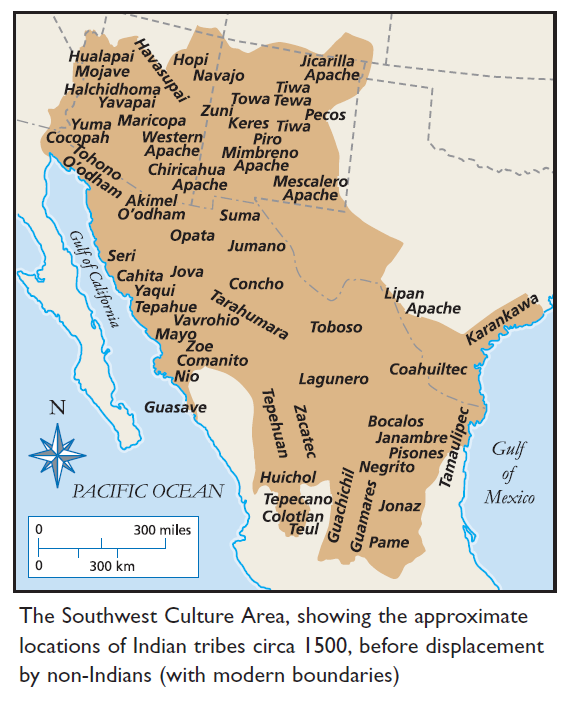
The region referred to as the Southwest Culture Area encompasses the current American Southwest, including most of Arizona and New Mexico, and small portions of California, Utah, Colorado, and Texas, as well as much of northern Mexico. The accompanying map displays both United States and Mexican territories, though the majority of tribes discussed in this book are situated within what is now the United States.
The topography of the Southwest Culture Area is diverse, ranging from the rugged high country of the Colorado Plateau in the north, with its flat-topped mesas separated by steep-walled canyons, to mountainous regions such as the Mogollon Mountains in New Mexico. Inland Mexico also contains highland regions of plateau and sierra. Much of the area is desert, including the Painted Desert along the Little Colorado River in Arizona, as well as desert lands along the Gulf of Mexico and Gulf of California.
The region's landscapes share an aridity that is characterized by an average annual rainfall ranging from less than four to less than 20 inches per year, with most precipitation occurring within a six-week period of summer. As a result of the extreme aridity, plants are sparse and animal life is limited primarily to small mammals and reptiles, such as deer, rabbits, squirrels, mice, and lizards, along with some large birds like eagles, hawks, and vultures. Dominant tree growth patterns in the Southwest vary depending on altitude and rainfall, including western evergreen trees, piñon and juniper trees, and mesquite trees, along with various species of cacti and desert shrubs.
Two primary ways of life evolved among the Southwest Indians: farming and nomadic hunting and raiding. Those who practiced agriculture were highly skilled farmers who could sustain sizable populations in permanent villages, even in arid environments. Most Indian villages in the Southwest had pueblo architecture, with adobe brick or stone structures featuring apartment-like levels connected by ladders, typically located on mesa tops. However, some villages were situated in the desert lowlands or along rivers, where inhabitants lived in different types of houses, such as small pole-framed huts covered with plant matter or earth. Nomadic hunters and gatherers who did not farm supplemented their diet by raiding the crops of village peoples. The two primary types of house among these people were wickiups, brush-covered structures, and hogans, earth-covered structures.
The tribes of the region can be grouped as follows, according to their different lifeways: agricultural Pueblo peoples, among them Rio Grande PUEBLO INDIANS (including KERES, TEWA, TIWA, and TOWA [JEMEZ]), HOPI, and ZUNI; agricultural desert and river peoples, among them AKIMEL O’ODHAM (PIMA), HAVASUPAI, HUALAPAI, MOJAVE, TOHONO O’ODHAM (PAPAGO), YAQUI, YAVAPAI, YUMA (QUECHAN); and the nomadic hunting-and-raiding peoples, APACHE and NAVAJO. The ancestors of some of these peoples belonged to the Anasazi, Hohokam, and Mogollon cultures (see SOUTHWEST CULTURES). The COAHUILTEC and KARANKAWA were desert peoples living near the Gulf of Mexico.
The Southwest Culture Area includes tribes of many languages. Of the above tribes, peoples of the Athapascan language family (or ATHAPASCANS, part of the Na- Dene language phylum) include Apache and Navajo. Peoples of the Kiowa-Tanoan language family (part of the Aztec-Tanoan language phylum) include some among the Rio Grande Pueblo Indians, the Tewa, Tiwa, and Towa (Jemez). Peoples of the Uto-Aztecan language family (part of the Aztec-Tanoan language phylum) include Akimel O’odham (Pima), Hopi, Tohono O’odham (Papago), and Yaqui. Peoples of the Yuman language family (part of the Hokan language phylum) include Havasupai, Hualapai, Mojave, Yavapai, and Yuma (Quechan). Peoples speaking language isolates include the Rio Grande Pueblo Indians known as Keres (Keresan language isolate of undetermined language affiliation); Zuni (Zunian language isolate of the Penutian language phylum); Coahuiltec (speaking the Coahuiltecan isolate); and Karankawa (speaking the Karankawan isolate).
Other Southwest peoples without entries in this book include the Cocopah, Halchidhoma, Halyikwamai, Kohuana, and Maricopa (all Yuman-speaking); Jumano (probably Uto-Aztecan speaking); and Sobaipuri (Uto- Aztecan-speaking). There are many northern Mexican agricultural and desert and river peoples as well, considered part of the Southwest Culture Area, who are not discussed in this book.